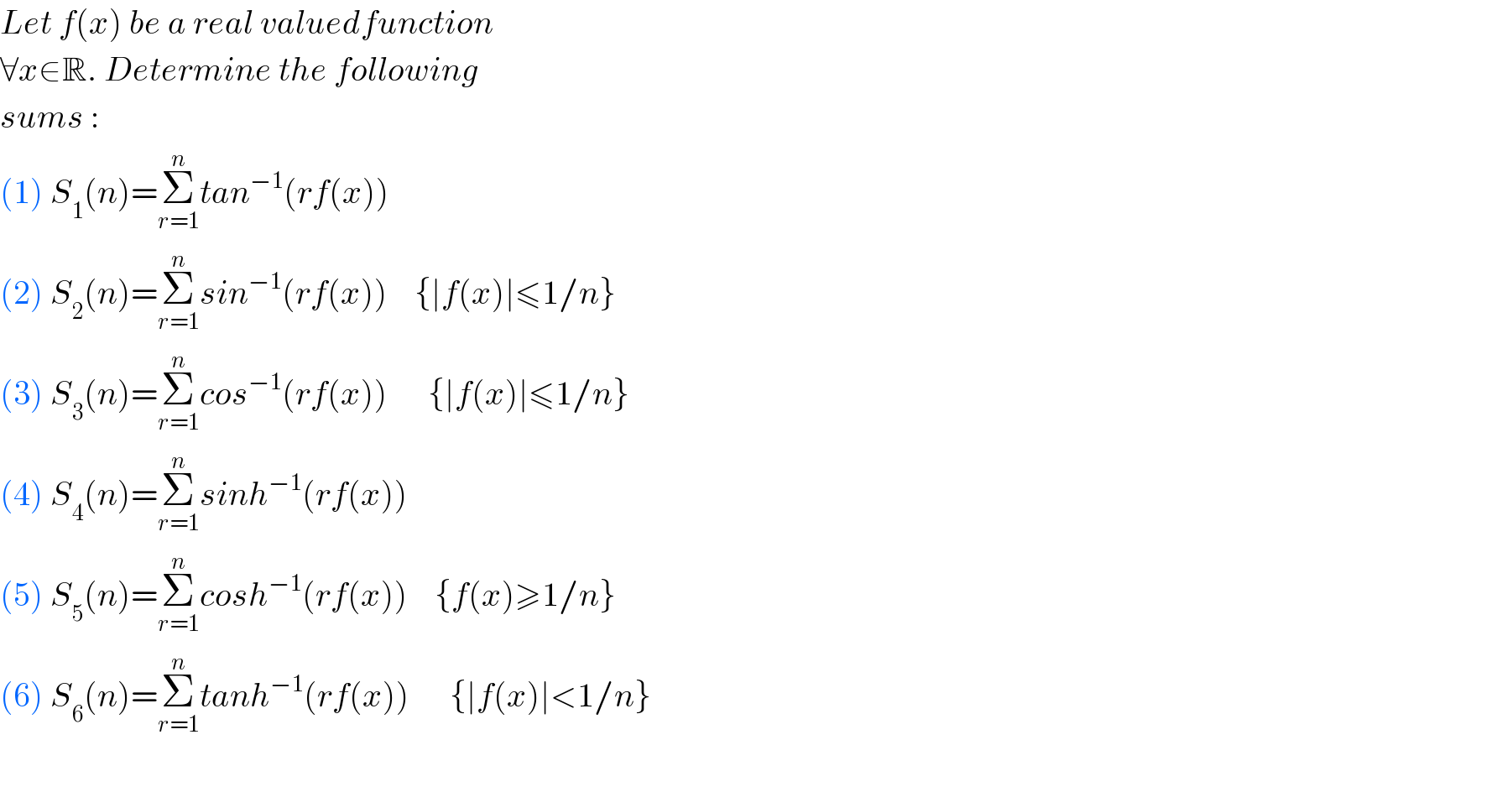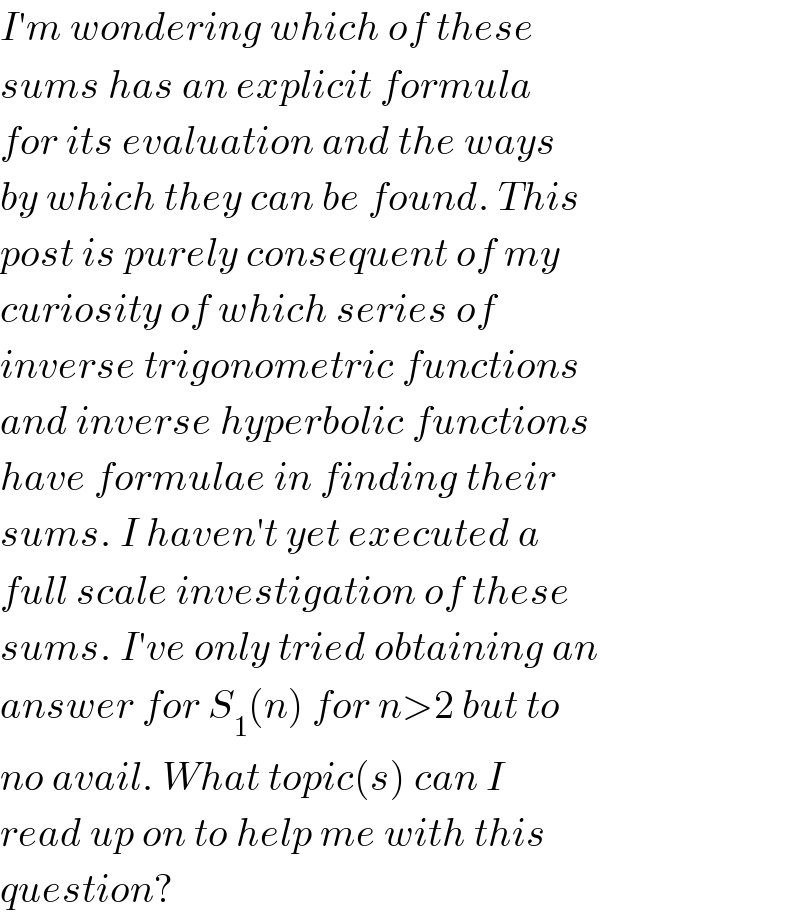Question Number 1437 by 112358 last updated on 03/Aug/15

$${Let}\:{f}\left({x}\right)\:{be}\:{a}\:{real}\:{valuedfunction} \\ $$$$\forall{x}\in\mathbb{R}.\:{Determine}\:{the}\:{following} \\ $$$${sums}\:: \\ $$$$\left(\mathrm{1}\right)\:{S}_{\mathrm{1}} \left({n}\right)=\underset{{r}=\mathrm{1}} {\overset{{n}} {\sum}}{tan}^{−\mathrm{1}} \left({rf}\left({x}\right)\right) \\ $$$$\left(\mathrm{2}\right)\:{S}_{\mathrm{2}} \left({n}\right)=\underset{{r}=\mathrm{1}} {\overset{{n}} {\sum}}{sin}^{−\mathrm{1}} \left({rf}\left({x}\right)\right)\:\:\:\:\left\{\mid{f}\left({x}\right)\mid\leqslant\mathrm{1}/{n}\right\} \\ $$$$\left(\mathrm{3}\right)\:{S}_{\mathrm{3}} \left({n}\right)=\underset{{r}=\mathrm{1}} {\overset{{n}} {\sum}}{cos}^{−\mathrm{1}} \left({rf}\left({x}\right)\right)\:\:\:\:\:\:\left\{\mid{f}\left({x}\right)\mid\leqslant\mathrm{1}/{n}\right\} \\ $$$$\left(\mathrm{4}\right)\:{S}_{\mathrm{4}} \left({n}\right)=\underset{{r}=\mathrm{1}} {\overset{{n}} {\sum}}{sinh}^{−\mathrm{1}} \left({rf}\left({x}\right)\right) \\ $$$$\left(\mathrm{5}\right)\:{S}_{\mathrm{5}} \left({n}\right)=\underset{{r}=\mathrm{1}} {\overset{{n}} {\sum}}{cosh}^{−\mathrm{1}} \left({rf}\left({x}\right)\right)\:\:\:\:\left\{{f}\left({x}\right)\geqslant\mathrm{1}/{n}\right\} \\ $$$$\left(\mathrm{6}\right)\:{S}_{\mathrm{6}} \left({n}\right)=\underset{{r}=\mathrm{1}} {\overset{{n}} {\sum}}{tanh}^{−\mathrm{1}} \left({rf}\left({x}\right)\right)\:\:\:\:\:\:\left\{\mid{f}\left({x}\right)\mid<\mathrm{1}/{n}\right\} \\ $$$$ \\ $$
Commented by prakash jain last updated on 05/Aug/15

$$\mathrm{Since}\:\mathrm{most}\:\mathrm{of}\:\mathrm{these}\:\mathrm{sums}\:\mathrm{can}\:\mathrm{be}\:\mathrm{written} \\ $$$$\mathrm{as}\:\mathrm{addition}.\:\mathrm{The}\:\mathrm{sum}\:\mathrm{is}\:\mathrm{simply}\:\mathrm{product}. \\ $$$$\mathrm{Am}\:\mathrm{i}\:\mathrm{missing}\:\mathrm{something}\:\mathrm{here}? \\ $$
Commented by 112358 last updated on 03/Aug/15
![Let y=sinh^(−1) x ⇒sinhy=x ∵ sinhy=((e^y −e^(−y) )/2)⇒((e^y −e^(−y) )/2)=x e^y −e^(−y) =2x ×e^y :⇒e^(2y) −2xe^y −1=0 ∴ e^y =((2x±(√(4x^2 +4)))/2)=x±(√(x^2 +1)) ⇒y=ln(x±(√(x^2 +1))) (√(x^2 +1))>(√x^2 )=x x−(√(x^2 +1))<0⇒y∈C ⇔ y=ln(x−(√(x^2 +1))) ∴ for y∈R, y=ln(x+(√(x^2 +1))) [∵(√(x^2 +1))>−x] i.e sinh^(−1) x=ln(x+(√(x^2 +1))) Also, tanh^(−1) x=(1/2)ln(((1+x)/(1−x))) ∣x∣<1 cosh^(−1) x=ln(x+(√(x^2 −1))) x≥1](https://www.tinkutara.com/question/Q1438.png)
$${Let}\:{y}={sinh}^{−\mathrm{1}} {x} \\ $$$$\Rightarrow{sinhy}={x} \\ $$$$\because\:{sinhy}=\frac{{e}^{{y}} −{e}^{−{y}} }{\mathrm{2}}\Rightarrow\frac{{e}^{{y}} −{e}^{−{y}} }{\mathrm{2}}={x} \\ $$$${e}^{{y}} −{e}^{−{y}} =\mathrm{2}{x} \\ $$$$×{e}^{{y}} :\Rightarrow{e}^{\mathrm{2}{y}} −\mathrm{2}{xe}^{{y}} −\mathrm{1}=\mathrm{0} \\ $$$$\therefore\:{e}^{{y}} =\frac{\mathrm{2}{x}\pm\sqrt{\mathrm{4}{x}^{\mathrm{2}} +\mathrm{4}}}{\mathrm{2}}={x}\pm\sqrt{{x}^{\mathrm{2}} +\mathrm{1}} \\ $$$$\Rightarrow{y}={ln}\left({x}\pm\sqrt{{x}^{\mathrm{2}} +\mathrm{1}}\right) \\ $$$$\sqrt{{x}^{\mathrm{2}} +\mathrm{1}}>\sqrt{{x}^{\mathrm{2}} }={x} \\ $$$${x}−\sqrt{{x}^{\mathrm{2}} +\mathrm{1}}<\mathrm{0}\Rightarrow{y}\in\mathbb{C}\:\Leftrightarrow\:{y}={ln}\left({x}−\sqrt{{x}^{\mathrm{2}} +\mathrm{1}}\right) \\ $$$$\therefore\:{for}\:{y}\in\mathbb{R},\:{y}={ln}\left({x}+\sqrt{{x}^{\mathrm{2}} +\mathrm{1}}\right)\:\:\:\:\left[\because\sqrt{{x}^{\mathrm{2}} +\mathrm{1}}>−{x}\right] \\ $$$${i}.{e}\:{sinh}^{−\mathrm{1}} {x}={ln}\left({x}+\sqrt{{x}^{\mathrm{2}} +\mathrm{1}}\right) \\ $$$${Also},\:{tanh}^{−\mathrm{1}} {x}=\frac{\mathrm{1}}{\mathrm{2}}{ln}\left(\frac{\mathrm{1}+{x}}{\mathrm{1}−{x}}\right)\:\:\:\:\mid{x}\mid<\mathrm{1} \\ $$$${cosh}^{−\mathrm{1}} {x}={ln}\left({x}+\sqrt{{x}^{\mathrm{2}} −\mathrm{1}}\right)\:\:\:\:\:\:\:\:\:\:{x}\geqslant\mathrm{1} \\ $$
Commented by 112358 last updated on 05/Aug/15

$${I}'{m}\:{wondering}\:{which}\:{of}\:{these}\: \\ $$$${sums}\:{has}\:{an}\:{explicit}\:{formula} \\ $$$${for}\:{its}\:{evaluation}\:{and}\:{the}\:{ways} \\ $$$${by}\:{which}\:{they}\:{can}\:{be}\:{found}.\:{This} \\ $$$${post}\:{is}\:{purely}\:{consequent}\:{of}\:{my} \\ $$$${curiosity}\:{of}\:{which}\:{series}\:{of}\: \\ $$$${inverse}\:{trigonometric}\:{functions} \\ $$$${and}\:{inverse}\:{hyperbolic}\:{functions} \\ $$$${have}\:{formulae}\:{in}\:{finding}\:{their} \\ $$$${sums}.\:{I}\:{haven}'{t}\:{yet}\:{executed}\:{a} \\ $$$${full}\:{scale}\:{investigation}\:{of}\:{these} \\ $$$${sums}.\:{I}'{ve}\:{only}\:{tried}\:{obtaining}\:{an} \\ $$$${answer}\:{for}\:{S}_{\mathrm{1}} \left({n}\right)\:{for}\:{n}>\mathrm{2}\:{but}\:{to} \\ $$$${no}\:{avail}.\:{What}\:{topic}\left({s}\right)\:{can}\:{I}\: \\ $$$${read}\:{up}\:{on}\:{to}\:{help}\:{me}\:{with}\:{this} \\ $$$${question}? \\ $$
